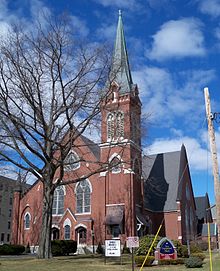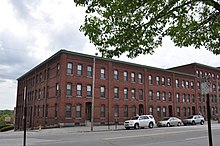John Thomas Fanning
| Naissance | |
|---|---|
| Décès | |
| Sépulture |
Lakewood Cemetery (en) |
| Activité |
John Thomas Fanning (1837-1911) est un architecte américain et un ingénieur en hydraulique. Sa principale contribution à la mécanique des fluides et à l'ingénierie hydraulique est le facteur de friction de Fanning qui est utilisé par les ingénieurs aujourd’hui encore pour calculer les pertes de pression dues aux frictions des flux à l'intérieur des tuyaux[1].
Biographie[modifier | modifier le code]



Fanning est né à Norwich dans le Connecticut. En 1861, il s’engage dans l’armée et participe à la guerre de Sécession sous le grade de colonel jusqu'à sa démobilisation. Après la guerre, il retourne à Norwich et y établit un bureau d'ingénierie. En 1872, il s'installe à Manchester, dans le New Hampshire, pour concevoir le nouveau réseau municipal d'eau de la ville[2]. En 1877, il fonde un second bureau en tant qu'architecte[3]. En 1885, en raison d’activités dans l'ouest des USA, il déménage à Minneapolis. Fanning a notamment travaillé pour les chemins de fer[4]
Après son déménagement à Manchester, John Thomas Fanning n'a plus exercé en tant qu'architecte.
L'architecture[modifier | modifier le code]
- Dunlap Building, 967 Elm St., Manchester, NH (1879)[5],[6]
- First Congregational Church, 508 Union St., Manchester, NH (1879–80)[7]
- Opera House Block, 30 Hanover St., Manchester, NH (1880–81)[6]
- Charles E. Balch House, 1779 Elm St., Manchester, NH (1881)[8]
- Battery Building, 153-155 Manchester St., Manchester, NH (1883) - Démoli[9]
- Carpenter and Bean Block, Elm & Dow Sts., Manchester, NH (1883)[9]
- New Hampshire Fire Insurance Co. Building, 886 Elm St., Manchester, NH (1885–86) - Démoli[10]
Références[modifier | modifier le code]
- (en) Cet article est partiellement ou en totalité issu de l’article de Wikipédia en anglais intitulé « John T. Fanning » (voir la liste des auteurs).
- (en) J. T. Fanning, A practical treatise on hydraulic and water-supply engineering, Рипол Классик, , 621 p. (ISBN 978-5-87581-042-8, lire en ligne)
- (en) « Carpenter and Bean Block NRHP Nomination », NATIONAL REGISTER OF HISTORIC PLACES REGISTRATION, ? (lire en ligne)
- The New-Hampshire Register, Farmer's Almanac and Business Directory for 1877. 1877.
- A Half Century of Minneapolis, Hudson Publishing Company, (lire en ligne), « Fanning, John Thomas »
- Dunlap Building NRHP Nomination. 2004.
- Engineering and Mining Journal 22 May 1880: 358.
- Chalmers, John. The Town Church of Manchester. 1903.
- New Hampshire Homes. 1895.
- NATIONAL REGISTER OF HISTORIC PLACES REGISTRATION, United States Department of the Interior:National Park Service OMBNo. 1024-0018, (lire en ligne), « Carpenter and Bean Block NRHP Nomination »
- Manufacturer and Builder July 1885: 158.
Liens externes[modifier | modifier le code]


